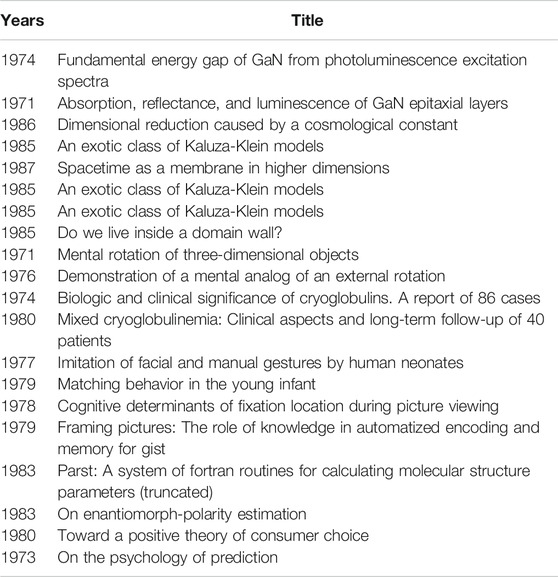- 1Netelabs, NET ESolutions (an NTT DATA Company), McLean, VA, United States
- 2Grainger College of Engineering, University of Illinois Urbana-Champaign, Urbana, IL, United States
- 3Department of Computer Science, University of Illinois Urbana-Champaign, Urbana, IL, United States
A Sleeping Beauty is a publication that is apparently unrecognized by citation for some period of time before experiencing a burst of recognition. Various reasons, including resistance to new ideas, have been attributed to such delayed recognition. We study this phenomenon in the special case of co-citations, which represent new ideas generated through the combination of existing ones. Using relatively stringent selection criteria derived from the work of others, we analyze a very large dataset of over 940 million unique co-cited article pairs, and identify 1,196 cases of delayed co-citations. We further classify these 1,196 cases with respect to amplitude, rate of citation, and disciplinary origin.
1. Introduction
The term “Sleeping Beauty” has been used to describe an article that is not well cited in the early years after its publication but experiences a sharp increase in the rate at which it is subsequently cited (van Raan, 2004). An implication is that the concept presented in such an article is “ahead of its time”, and that 93 resistance to its ideas may have delayed its recognition.
Causes for resistance (Barber, 1961; Cole, 1970), and delayed recognition (Garfield, 1970; 1980) have been postulated that include 1) information overload from the large amount of information available, 2) modest communication skills of authors, 3) insufficient promotion of ideas, 4) conflict with existing theory and experimental data, 5) the author’s position in the social hierarchy of science, 6) multiple discovery, 7) the management structures of scientific institutions, 8) and the conservative nature of establishments.
The Sleeping Beauty phenomenon, and variants of it, have been extensively studied in different datasets, and some degree of agreement exists that a fraction of the scientific literature exhibits citation kinetics that suggest delayed but eventual recognition of new ideas (Glänzel et al., 2003; Redner, 2005; Braun et al., 2010; Li, 2014). The size of this fraction has received different estimates as well as criteria for defining these estimates (Glänzel and Garfield, 2004; Ke et al., 2015; Li and Ye, 2016; van Raan and Winnink, 2019). Imaginative metaphors have also emerged to describe Sleeping Beauty variants that have been subsequently discussed in terms of their precision and impact (Sugimoto and Mostafa, 2018).
While earlier studies examined small datasets, subsequent ones have considered large samples of the literature, for example, 22 million publications in Ke et al. (2015). In studying the Sleeping Beauty phenomenon, both parameterized and parameter-free approaches have been used (van Raan, 2004; Costas et al., 2010; Li et al., 2014; Ke et al., 2015; Ye and Bornmann, 2018) with partially overlapping results.
While the research cited above has focused on single publications, new ideas also result from combining two previously independent ones. The recognition of such novel ideas can be examined by co-citation analysis (Marshakova-Shaikevich, 1973; Uzzi et al., 2013; Boyack and Klavans, 2014; Wang et al., 2017; Bradley et al., 2020). Co-citation analysis has also been used to identify the so-called “princes” that awaken Sleeping Beauties by (Teixeira et al., 2017; Zong et al., 2018).
Delayed recognition in co-cited article pairs has been briefly explored (Devarakonda et al., 2020) using simplified criteria derived from prior Sleeping Beauty studies on single publications (van Raan, 2004; Ke et al., 2015; van Raan and Winnink, 2019). The authors of this study (Devarakonda et al., 2020), which examined 33.6 million pairs, reported 24 co-cited pairs exhibiting delayed recognition in the 99th percentile of 33.6 million co-citation frequencies, and proposed the term delayed co-citations for such cases. While this initial exploration, albeit at scale, only considered reference pairs where each member of a pair was in the 99th percentile of highly cited articles in Scopus, its results suggest that delayed recognition in co-cited pairs is relatively uncommon.
In this article, we examine a much larger dataset, approximately 940 million pairs of articles. We identify co-cited article pairs that exhibit delayed recognition according to criteria derived from the work of van Raan (2004); van Raan and Winnink (2019) and Ke et al. (2015). We also ask whether individual articles found in delayed co-citation pairs can be labeled as Sleeping Beauties.
2. Materials and Methods
We have previously described a dataset of 33.6 million cited pairs each belonging to the top 1% of cited articles in the Scopus bibliography (Devarakonda et al., 2020; Figure 2). In the present study, we include all co-cited pairs from references cited by articles published in Scopus in the 11 year period, 1985–1995, not only those drawn from the top 1% of cited articles.
To assemble and analyze a working dataset, we first exported 95,524,693 publication records from Scopus (all citation types) as a citation graph consisting of an edgelist and a nodelist, imported these data into a graph database (Neo4j) treating publications as nodes and citations as edges. After creating indexes to improve performance, we selected all publications of citation type “article” published in the years 1985–1995 (inclusive of both) that had at least five cited references each. In counting references, we only considered references with complete Scopus records. Incomplete references and those with cryptic placeholder identifiers were removed from the dataset. We also filtered rare cases in the data where a publication cites itself, or if the publication date of a cited reference was missing or greater than the publication date of its citing article. Selection of publications with at least five references was performed after curating references.
We used a combination of SQL, Cypher, and Python to manage and analyze this volume of data. After initial comparison of SQL vs Cypher, we chose, on the basis of simplicity and performance, to use Cypher queries in Neo4j to generate all pairwise
For efficiency, we divided the data into batches for parallel processing using the Neo4j 4.0 graph database and the GNU Parallel utility. After tuning experiments on a test set of one million pairs using Neo4j in a Centos 7.5 virtual machine with 128 Gb of RAM and 16 vCPUs in the Microsoft Azure environment, we set batch size to 1,000 pairs and the degree of parallelization to 15 cores. Under these conditions, it took roughly 11 min to compute co-citation frequencies for a batch of 1,000 pairs. We divided these 940 million pairs into nine subsets of around 100 million pairs each and processed them at the rate of approximately 19 h per subset. Our code for parsing and updating Scopus XML data, a PostgreSQL schema for Scopus data, SQL, Cypher, and Python scripts used in this study is freely available from a Github repository (Korobskiy et al., 2019).
The simple Cypher query we used to calculating co-citation frequencies of pairs in Neo4j is shown below. The input to the query is a csv file containing two columns of article identifiers with each row representing a co-cited pair.
Frequencies thus calculated, were loaded back into PostgreSQL. For kinetic analysis, we selected all pairs with a co-citation frequency
After generating a dataset of 940 million pairs, we applied three relatively conservative conditions to identify cases of delayed co-citation: 1) a minimum peak (annual) co-citation frequency for a pair of at least 20; 2) a minimum total co-citation frequency of at least 100; 3) a requirement both members of a co-cited pair should be published no earlier than 1970. We then identified delayed co-citation cases by setting two more conditions: 1) a minimum sleeping duration of 10 years as measured from the first possible year of co-citation (the more recent publication year of the two articles), 2) during this sleeping period of 10 years or more, the average co-citation frequency should be at most 1 with no more than two co-citations in any one year.
We calculated the Beauty Coefficient using the equation below for 1) a single article as described in detail by Ke et al. (2015), and 2) for co-cited pairs as described in Devarakonda et al. (2020); we treated the first possible year of co-citation equivalently to the year of publication for a single article.
where B is the Beauty Coefficient, t is a point in time describing the age of a publication, and
We also calculated the slope between the co-citation frequency of the awakening year and the peak frequency. For single publications, we narrowed the criteria of van Raan and Winnink (2019) to consider only one sleeping period of 10 years or greater; depth of sleep (average citation rate during sleep) of at most 1; an awakening period of 5 years; and an average co-citation frequency during the awakening period (which is defined as awakening citation intensity by van Raan) of at least 5.
We use the term Sleeping Beauty when referring to delayed recognition in individual articles that were identified using prior methodology. For co-citations, we use delayed co-citation or delayed recognition.
3. Results and Discussion
In this study of delayed co-citations, we first examined cited references from 3,433,578 publications in the Scopus database. The criteria for selection of these publications were that they were classified as “article,” that they were published in the period 1985–1995, and they contained at least five cited references each. We generated all possible co-cited pairs for the references in these articles and de-duplicated them across articles. since the same reference pair can occur in more than one article. Then we measured the co-citation frequency of each pair across the entire Scopus database by counting all co-citation events from the first possible year of co-citation onwards through 2018 (Figure 1; Table 1).
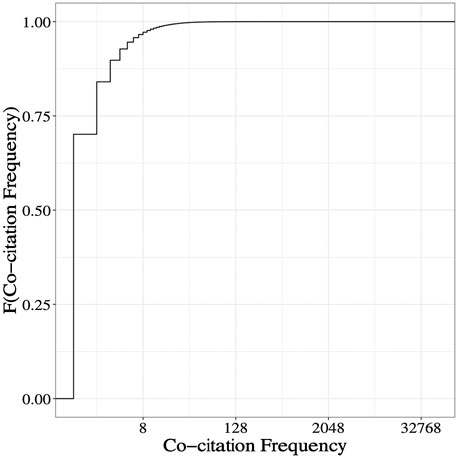
FIGURE 1. Frequencies of
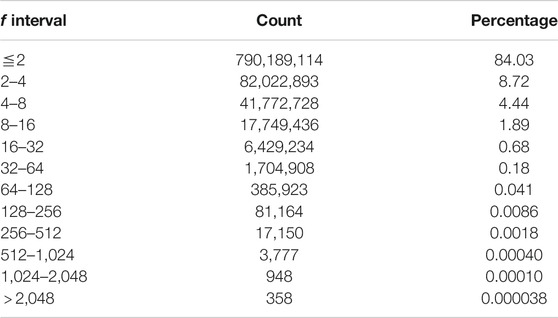
TABLE 1. Distribution of 940 million Co-citation Frequencies. The count of co-cited pairs in each frequency class as well as the percentage relative to the total number of 940,357,633 is shown. Counts include the lower bound in each class and exclude the upper bound.
The data in Figure 1 show a highly skewed distribution of co-citation frequencies across a large dataset. Roughly 84% of the pairs have a total co-citation frequency of two or less, and the 99th percentile is 16 although each pair had at least 10 years to accumulate co-citations. Even for a pair of articles from the most recent year in our data, 1995, this frequency of 16 corresponds to less than one co-citation per year on average. Thus, only a small fraction of pairs in these data have co-citation frequencies greater than two per year. One might consider that the reasons advanced for delayed recognition described in the Introduction could also contribute to such modest recognition or even acknowledgment of non-merit.
Beyond a high level understanding of the distribution of co-citation frequencies, however, we are interested in frequently co-cited publications, which are derived from highly cited publications (Small, 1973), and are of interest to the community. Thus, we subset the data using a conservative threshold of 100 for total co-citation frequency along with a peak annual co-citation frequency of at least 20. These criteria are analogous to those proposed by van Raan (2004) and Redner (2005). After applying these two further restrictions, the number of co-cited pairs in consideration was reduced to 51,613 (approximately 0.055% of the total number of pairs).
We applied further conditions to these 51,613 pairs to determine whether they qualified as cases of delayed co-citation: 1) a co-cited pair should have experienced dormancy in citation (a period of “sleep”) for at least 10 years during which it should have received no more than two co-citations per year. This period of dormancy ended in the first year that the pair received more than two co-citations. To be labeled a case of delayed recognition, we also required that the awakening period that follows the sleeping period was characterized by 2) a peak annual co-citation frequency of at least 20. These criteria when collectively applied, identified 1,196 cases of delayed co-citation, whose characteristics are summarized in Table 2. We also note that roughly 18% (223/1,196) pairs were connected by direct citation to each other.
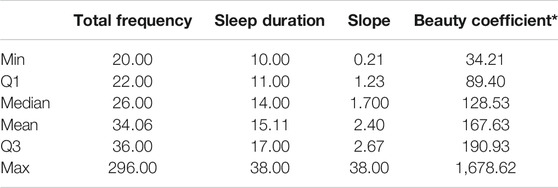
TABLE 2. Summary Statistics of 1,196 Delayed Co-citation Pairs. Criteria for selection were a minimum sleeping period of 10 years and a minimum peak of 20 citations in any year. Q1 and Q3 refer to the first and third quartile respectively.
Interestingly, these 1,196 pairs are derived from only 1,267 of a possible 2,392 individual publications indicating that some members of frequently co-cited pairs are found in multiple pairs. This observation is consistent with a pair of articles concerning methods in biochemistry, contributing to over 40,000 different co-cited pairs with frequencies of at least 10 (Devarakonda et al., 2020).
A logical question is whether any of these 1,267 individual publications would exhibit delayed recognition (be classified as Sleeping Beauties). Applying van Raan’s criteria (Section 2), we identify 128 of these 1,267 publications. Interestingly, 27 of the 1,196 delayed co-citation pairs were cases where both members of a delayed co-citation pair would qualify as Sleeping Beauties. Thus, delayed recognition can occur without a requirement that at least one member of a co-cited pair with delayed recognition should have Sleeping Beauty characteristics. These observations also suggest that while high-referencing fields such as biology (Small and Greenlee, 1980) might be advantaged by our selection criteria, the thresholds we set do not entirely exclude other fields. Accordingly, continuing this work with field normalization of co-citation frequencies, to the extent possible, is warranted.
In contrast to co-citation frequencies for delayed co-citations (Figure 2), which range from 20 to 260; citation counts for the 1,267 publications that contribute to these 1,196 delayed co-citations range from 121 to 190,832 with 72 of these publications having citation counts of greater than 10,000.
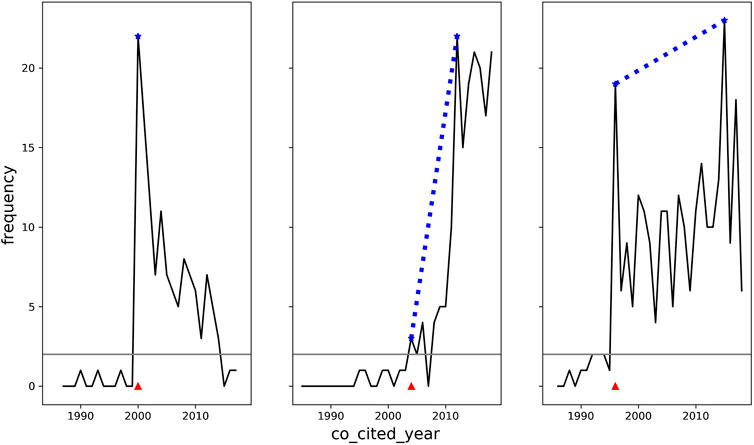
FIGURE 2. Kinetics of Co-citation Frequencies for Delayed Co-citations. Three sample plots are shown from 1,196 delayed co-citations selected for maximum slope (left panel). mean slope (middle panel), and minimum slope (right panel) of a line connecting the co-citation frequency of the awakening year to the co-citation frequency of the peak year. Total co-citation frequencies for these three plots were 131, 174, and 254, with peaks of 22, 22, and 23, and slopes of NA, 2.38, and 0.21, respectively. The red triangle marks the awakening year and the dotted blue line, the slope. The slope in the left panel is NA since the peak year is the awakening year. The article pairs shown above are 1) Spacetime as a membrane in higher dimensions (Gibbons 1987) and An exotic class of Kaluza-Klein models (Visser, 1985), 2) Formulation of the reaction coordinate (Fukui 1970) and Ab initio effective core potentials for molecular calculations. Potentials for main group elements Na to Bi (Wadt and Hay, 1985), 3) A proposed grading system for arteriovenous malformations (Spetzler, 1986) and arteriovenous malformations of the brain: Natural history in unoperated patients (Crawford et al., 1986).
However, other co-citation frequencies do exceed the seemingly modest frequencies noted for delayed co-citations. For example, Becke (1993) and Lee et al. (1988), a pair of articles from the field of physical chemistry, have been co-cited over 51,000 times but do not exhibit delayed citation kinetics. It should also be noted that these articles have individually been cited over 70,000 times each. Similarly, 1,357 pairs from the data shown in Figure 2 have co-citation frequencies greater than 1,000.
We observe (Figure 1), that the 90th, 95th, and 99th percentiles of co-citation frequencies in our dataset are 4, 6, and 16 respectively. In comparison. the 90th, 95th, and 99th percentile of citation frequencies of
To examine rates of awakening, we also calculated the slope between the co-citation frequency in the first awakening year and the frequency of the peak year and noted a fairly broad range of slopes with a mean of 2.4 (Table 2). The kinetics of co-citation are visualized in Figure 2, for three examples with the maximum slope, the mean slope, and the minimum slope observed.
Of 1,196 delayed co-citations, the slope could not be computed for 10 pairs because the peak year was the year of awakening. This small number of cases, suggest sudden recognition of the concepts represented by these pairs (Table 3. These 10 pairs span the areas of LED technology, cosmology, immunology, psychology, and computational science. One publication from 1985 titled, “An exotic class of Kaluza-Klein models” appears in 3 of 10 pairs and the author himself refers, in 1999, to “renewed interest due to the explosion of activity in the non compact extra dimensions variant of the Kaluza Klein model” (Visser, 1999).
We also examined lesser co-citation frequencies, between 20 and 100, and observed 5,928,815 pairs. After removing pairs with 1) less than 10 years of kinetic data (the difference between publication year and peak year is less than 10 years) 2) a negative Beauty Coefficient, which describes articles whose citations growing linearly with time or with a citation trajectory that is a concave function of time, 3) without at least one peak of frequency 20, then the number reduced to 13,057 pairs. Of these 12,920 had only a single peak of 20 or greater and may be similar to “flash in the pan” citations (Costas et al., 2010; Li, 2014). Given our focus on frequently co-cited pairs, we did not study these further.
An appealing alternative approach for delayed co-citations and Sleeping Beauties is the Beauty Coefficient. We computed the Beauty Coefficient (Materials and Methods) for these 1,196 pairs observing a range of 34.21–1678.62. These data are summarized in Table 2. Given co-citation frequencies being generally lower than citation frequencies, the top 15 Beauty Coefficient values of the 1,196 delayed co-citations range from 712.47 to 1678.62, which appear comparable given lower co-citation frequencies to the top 15 single articles described by Ke et al. (2015), all above 2,000.
Ke and colleagues comment that parameterized approaches in preceding studies have suffered from being somewhat arbitrary. Arbitrariness may not have impeded discovery, for example Redner’s work on the physics literature (Redner, 2005) with its selection threshold of 250 citations. Further, while the Beauty Coefficient is parameter free, the choice of selection threshold is left to the user leaving the door open for arbitrary selection thresholds. We consider this a strength of the measure since it can be used in contextual studies. The approach of van Raan is also intuitive and flexible but does not consider the maximum number of citations received as an important parameter to be tuned. The cases with a sleeping period of ten years, and a citation rate of 5 for the next 5 years, would satisfy requirements for delayed recognition but are perhaps less noteworthy.
Finally, to ask which fields these 1,196 delayed co-citations are found in, we mapped them to the All Science Journal Classification (ASJC) maintained by Scopus, which consists of 27 major subject area categories. The data are represented in Figure 3 but should be interpreted in the light of these subject area labels being derived from journals and that an article may have more than one label. Even so, the data suggest that delayed co-citations, as we define them in our dataset are largely drawn from the domain of biochemistry, genetics, and molecular biology followed by physics, computer science, chemistry, and engineering. These observations are slightly different from (Ke et al., 2015; Figure 4) with Biochemistry, Genetics, and Molecular Biology dominating in our set but those authors studied single publications from a different data source, and a different time period.
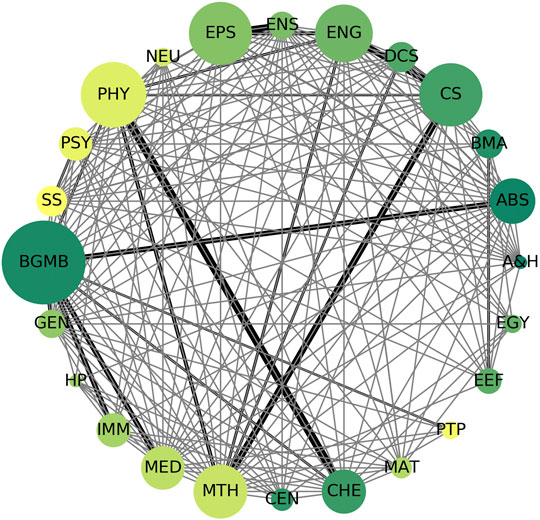
FIGURE 3. Disciplinary composition of 1,196 Delayed Co-citations. Each node represents a major subject area in the Scopus ASJC classification. Node size is scaled to the number of articles in a given subject area. Edge thickness indicates the number of pairs with one member in each of the two nodes connected by the edge. Major subject areas are abbreviated in the graphic: BGMB, Biochemistry, Genetics and Molecular Biology; SS, Social Sciences; PSY, Psychology; PHY, Physics and Astronomy; NEU, Neuroscience; EPS, Earth and Planetary Sciences; ENS, Environmental Science; ENG, Engineering; DCS, Decision Sciences; CS, Computer Science; BMA, Business, Management, and Accounting; ABS, Agricultural and Biological Sciences; A&H, Arts and Humanities; EGY, Energy; EEF, Economics, Econometrics and Finance; PTP, Pharmacology, Toxicology and Pharmaceutics; MAT, Material Sciences; CHE, Chemistry; CEN, Chemical Engineering; MTH, Mathematics; MED, Medicine; IMM, Immunology and Microbiology; HP, Health Professions; GEN, General.
4. Conclusion
In a large-scale exploration of the kinetics of co-citation (more than 940 million unique article pairs), we have identified 1,196 cases of delayed co-citation using criteria largely derived from the work of van Raan and Ke. We acknowledge that our selection criteria, while guided by positional statistics and intuitive preference, suffers from some degree of arbitrariness. As with all bibliometric data, coverage and data quality also influence discovery. Thus, we have tried to identify co-cited pairs of higher frequency since the trends in such cases are more likely to be reproducible across other data sources. Relaxing these conditions, will identify additional cases. Our goal was to identify a set of delayed co-cited pairs that can be studied, in the longer term, to understand the reasons for the patterns of citation. This future task will require a greater understanding of the fields in which such delayed co-citations occurred and ideally should be coupled to qualitative techniques. Resolving these observations in a finer-grained manner with respect to kinetics and discipline would also be informative.
Data Availability Statement
The datasets presented in this article are not readily available because Scopus data has licensing restrictions and cannot be redistributed. The studies are reproducible to persons with a license from Elsevier, the vendor of Scopus. Requests to access the datasets should be directed to bmV0ZWxhYnNAbmV0ZS5jb20=
Author Contributions
WZ: Conceptualization; Methodology; Investigation; Writing—Review and Editing. DK: Methodology; Writing–Review and Editing; GC: Conceptualization; Methodology; Investigation; Writing—Original Draft; Writing—Review and Editing; Funding Acquisition, Resources; Supervision.
Funding
Research and development reported in this publication was partially supported by federal funds from the National Institute on Drug Abuse (NIDA), National Institutes of Health, U.S. Department of Health and Human Services, under Contract Nos. HHSN271201700053C (N43DA-17-1216) and HHSN271201800040C (N44DA-18-1216).
Disclaimer
Data used in this study derive from the ERNIE project, which involves a collaboration with Elsevier. The content of this publication is solely the responsibility of the authors and does not necessarily represent the official views of the National Institutes of Health or Elsevier. Elsevier staff did not have a role in design, manuscript-writing, or review and interpretation of results.
Conflict of Interest
The authors declare that the research was conducted in the absence of any commercial or financial relationships that could be construed as a potential conflict of interest.
Acknowledgments
We thank our Elsevier colleagues for their support of the ERNIE project.
Supplementary Material
The Supplementary Material for this article can be found online at: https://www.frontiersin.org/articles/10.3389/frma.2020.577131/full#supplementary-material.
References
Barber, B. (1961). Resistance by scientists to scientific discovery. Science 134, 596–602. doi:10.1126/science.134.3479.596
Becke, A. D. (1993). Density-functional thermochemistry. III. The role of exact exchange. J. Chem. Phys. 98, 5648–5652. doi:10.1063/1.464913
Boyack, K., and Klavans, R. (2014). “Atypical combinations are confounded by disciplinary effects,” in International conference on science and technology indicators. Leiden, The Netherlands: CWTS-Leiden University, 49–58.
Bradley, J., Devarakonda, S., Davey, A., Korobskiy, D., Liu, S., Lakhdar-Hamina, D., et al. (2020). Co-citations in context: disciplinary heterogeneity is relevant. Quantitat. Sci. Stud. doi:10.1162/qssä00007
Braun, T., Glänzel, W., and Schubert, A. (2010). On Sleeping Beauties, Princes and other tales of citation distributions. Res. Eval. 19, 195–202. doi:10.3152/095820210X514210
Cole, S. (1970). Professional standing and the reception of scientific discoveries. Am. J. Sociol. 76, 286–306. doi:10.1086/224934
Costas, R., van Leeuwen, T. N., and van Raan, A. F. (2010). Is scientific literature subject to a ’sell-by-date’? a general methodology to analyze the ‘durability’of scientific documents. J. Am. Soc. Inf. Sci. Technol. 61, 329–339. doi:10.1002/asi.21244
Crawford, P. M., West, C. R., and Chadwick, M. D. (1986). Arteriovenous malformations of the brain: natural history in unoperated patients. J. Neurol. Neurosurg. Psychiatry 49, 1–10. doi:10.1136/jnnp.49.1.1
Devarakonda, S., Bradley, J., Korobskiy, D., Warnow, T., and Chacko, G. (2020). Frequently co-cited publications: features and kinetics. Quantitat. Sci. Stud. Preprint ArXiv http://arxiv.org/abs/2005.04793.
Fukui, K. (1970). Formulation of the reaction coordinate. J. Phys. Chem. 74, 4161–4163. doi:10.1021/j100717a029
Garfield, E. (1980). Premature discovery or delayed recognition - why?. Essays Inf. Sci. 4, 488–493.
Garfield, E. (1970). Would Mendel’s work have been ignored if the Science Citation Index was available 100 years ago?. Essays Inf. Sci. 1, 69–70.
Gibbons, G. W., and Wiltshire, D. L. (1987). Spacetime as a membrane in higher dimensions. Nucl. Phys. B 287, 717–742. doi:10.1016/0550-3213(87)90125-8
Glänzel, W., Schlemmer, B., and Thijs, B. (2003). “Better late than never?,” in On the chance to become highly cited only beyond the standard bibliometric time horizon. Leuven: Katholieke Universiteit Leuven, 58. doi:10.1023/B:SCIE.0000006881.30700
Ke, Q., Ferrara, E., Radicchi, F., and Flammini, A. (2015). Defining and identifying sleeping beauties in science. Proc. Natl. Acad. Sci. Unit. States Am. 112, 7426–7431. doi:10.1073/pnas.1424329112
Korobskiy, D., Davey, A., Liu, S., Devarakonda, S., and Chacko, G. (2019). Enhanced research network informatics environment (ERNIE). Github repository. San Francisco, CA: NET ESolutions Corporation.
Lee, C., Yang, W., and Parr, R. G. (1988). Development of the Colle-Salvetti correlation-energy formula into a functional of the electron density. Phys. Rev. B 37. 785–789. doi:10.1103/PhysRevB.37.785
Li, J. (2014). Citation curves of “all-elements-sleeping-beauties”: “flash in the pan” first and then “delayed recognition”. Scientometrics 100, 595–601. doi:10.1007/s11192-013-1217-z
Li, J., Shi, D., Zhao, S. X., and Ye, F. Y. (2014). A study of the “heartbeat spectra” for “sleeping beauties”. J. Informetrics 8, 493–502. doi:10.1016/j.joi.2014.04.002
Li, J., and Ye, F. Y. (2016). Distinguishing sleeping beauties in science. Scientometrics 108, 821–828. doi:10.1007/s11192-016-1977-3
Marshakova-Shaikevich, I. (1973). System of document connections based on references. Sci. Tech. Information Serial VINITI 6, 3–8.
Redner, S. (2005). Citation statistics from 110 years of physical review. Phys. Today 58, 49–54. doi:10.1063/1.1996475
Small, H. (1973). Co-citation in the scientific literature: a new measure of the relationship between two documents. J. Am. Soc. Inf. Sci. 24, 265–269. doi:10.1002/asi.4630240406
Small, H., and Greenlee, E. (1980). Citation context analysis of a co-citation cluster: recombinant-DNA. Scientometrics 2, 277–301. doi:10.1007/BF02016349
Spetzler, R. F., and Martin, N. A. (1986). A proposed grading system for arteriovenous malformations. J. Neurosurg. 65, 476–483. doi:10.3171/jns.1986.65.4.0476
Sugimoto, C., and Mostafa, J. (2018). A note of concern and context: on careful use of terminologies. J. Assoc. Inform. Sci. Technol. 69, 347–348. doi:10.1002/asi.24014
Teixeira, A. A., Vieira, P. C., and Abreu, A. P. (2017). Sleeping beauties and their princes in innovation studies. Scientometrics 110, 541–580. doi:10.1007/s11192-016-2186-9
Uzzi, B., Mukherjee, S., Stringer, M., and Jones, B. (2013). Atypical combinations and scientific impact. Science 342, 468–472. doi:10.1126/science.1240474
van Raan, A. F. J. (2004). Sleeping beauties in science. Scientometrics 59, 467–472. doi:10.1023/B:SCIE.0000018543.82441.f1
van Raan, A. F. J., and Winnink, J. J. (2019). The occurrence of ‘Sleeping Beauty’ publications in medical research: their scientific impact and technological relevance. PLoS One 14, 1–34. doi:10.1371/journal.pone.0223373
Visser, M. (1985). An exotic class of Kaluza-Klein models. Phys. Lett. B 159, 22–25. doi:10.1016/0370-2693(85)90112-1
Wadt, W. R., and Hay, P. J. (1985). Ab initio effective core potentials for molecular calculations. Potentials for main group elements Na to Bi. J. Chem. Phys. 82, 284–298. doi:10.1063/1.448800
Wang, J., Veugelers, R., and Stephan, P. (2017). Bias against novelty in science: a cautionary tale for users of bibliometric indicators. Res. Pol. 46, 1416–1436. doi:10.1016/j.respol.2017.06.006
Ye, F. Y., and Bornmann, L. (2018). “smart girls” versus “sleeping beauties” in the sciences: the identification of instant and delayed recognition by using the citation angle. J. Assoc. Inf. Sci. Technol. 69, 359–367. doi:10.1002/asi.23846
Keywords: delayed recognition, co-citation, bibliometrics, graph database, sleeping beauty
Citation: Zhao W, Korobskiy D and Chacko G (2021) Delayed Recognition: A Co-Citation Perspective. Front. Res. Metr. Anal. 5:577131. doi: 10.3389/frma.2020.577131
Received: 28 June 2020; Accepted: 16 November 2020;
Published: 19 February 2021.
Edited by:
Dangzhi Zhao, University of Alberta, CanadaReviewed by:
Kevin Boyack, SciTech Strategies, Inc., United StatesChaomei Chen, Drexel University, United States
Copyright © 2021 Zhao, Korobskiy and Chacko. This is an open-access article distributed under the terms of the Creative Commons Attribution License (CC BY). The use, distribution or reproduction in other forums is permitted, provided the original author(s) and the copyright owner(s) are credited and that the original publication in this journal is cited, in accordance with accepted academic practice. No use, distribution or reproduction is permitted which does not comply with these terms.
*Correspondence: George Chacko, bmV0ZWxhYnNAbmV0ZS5jb20=
 Wenxi Zhao
Wenxi Zhao Dmitriy Korobskiy1
Dmitriy Korobskiy1 George Chacko
George Chacko
